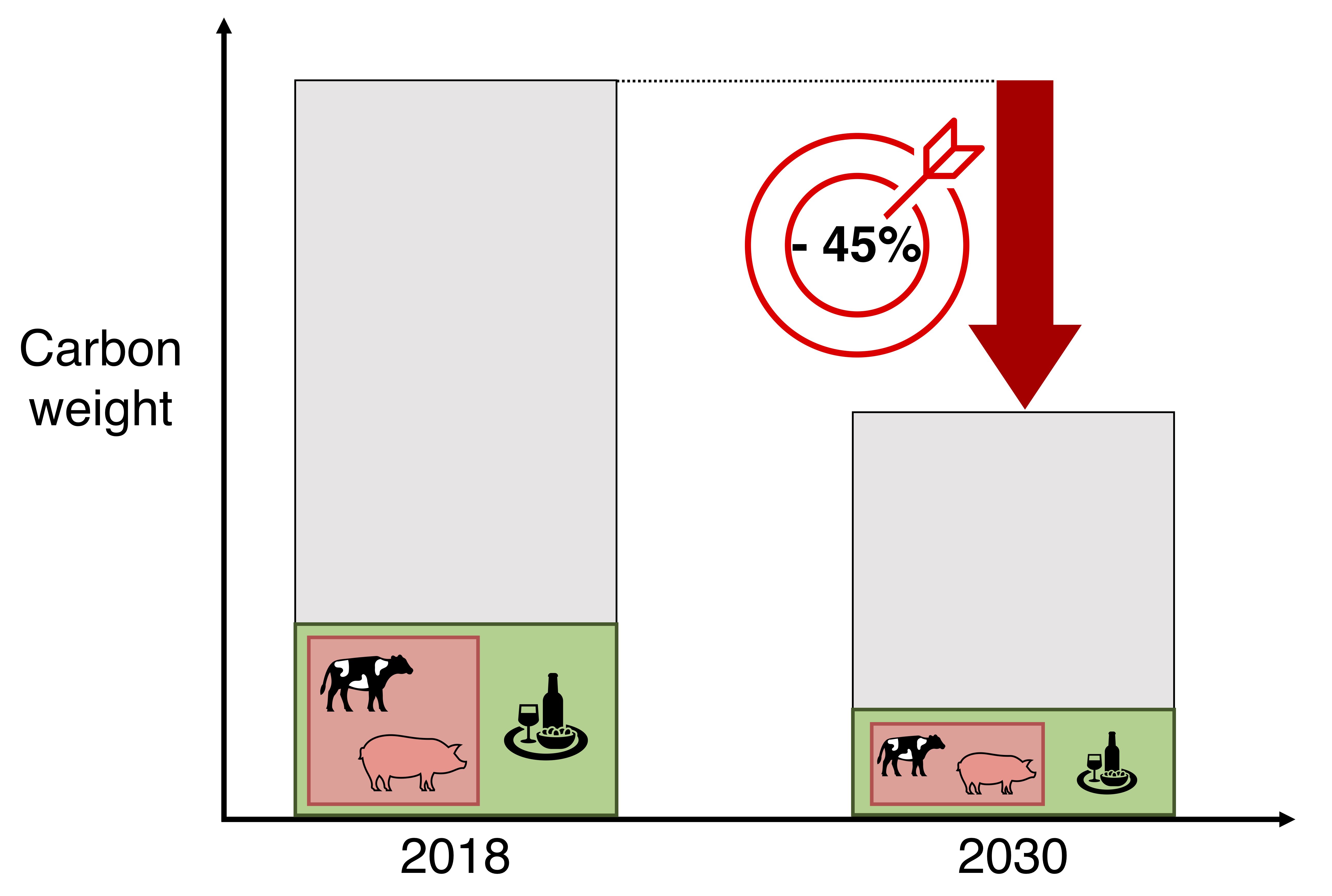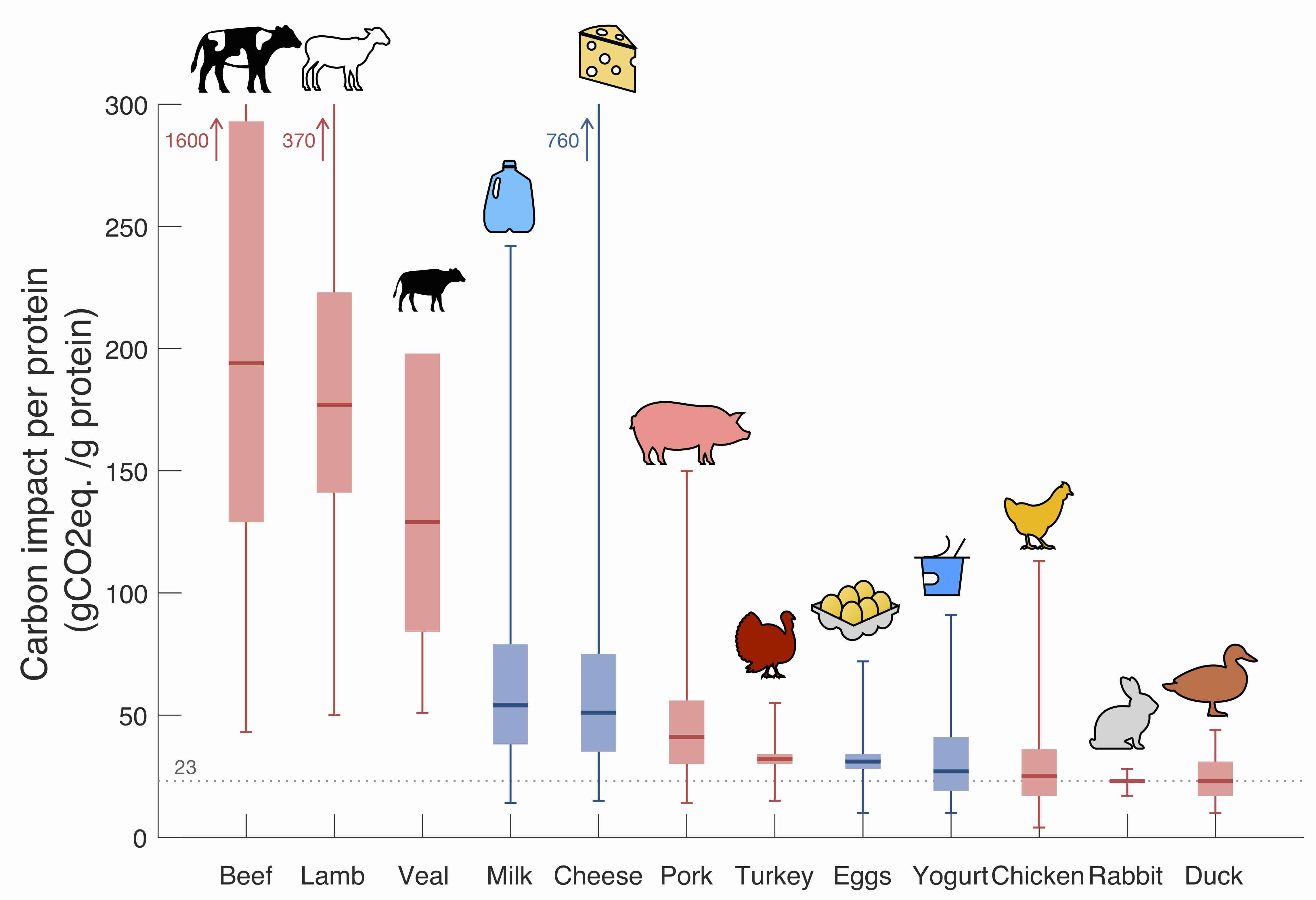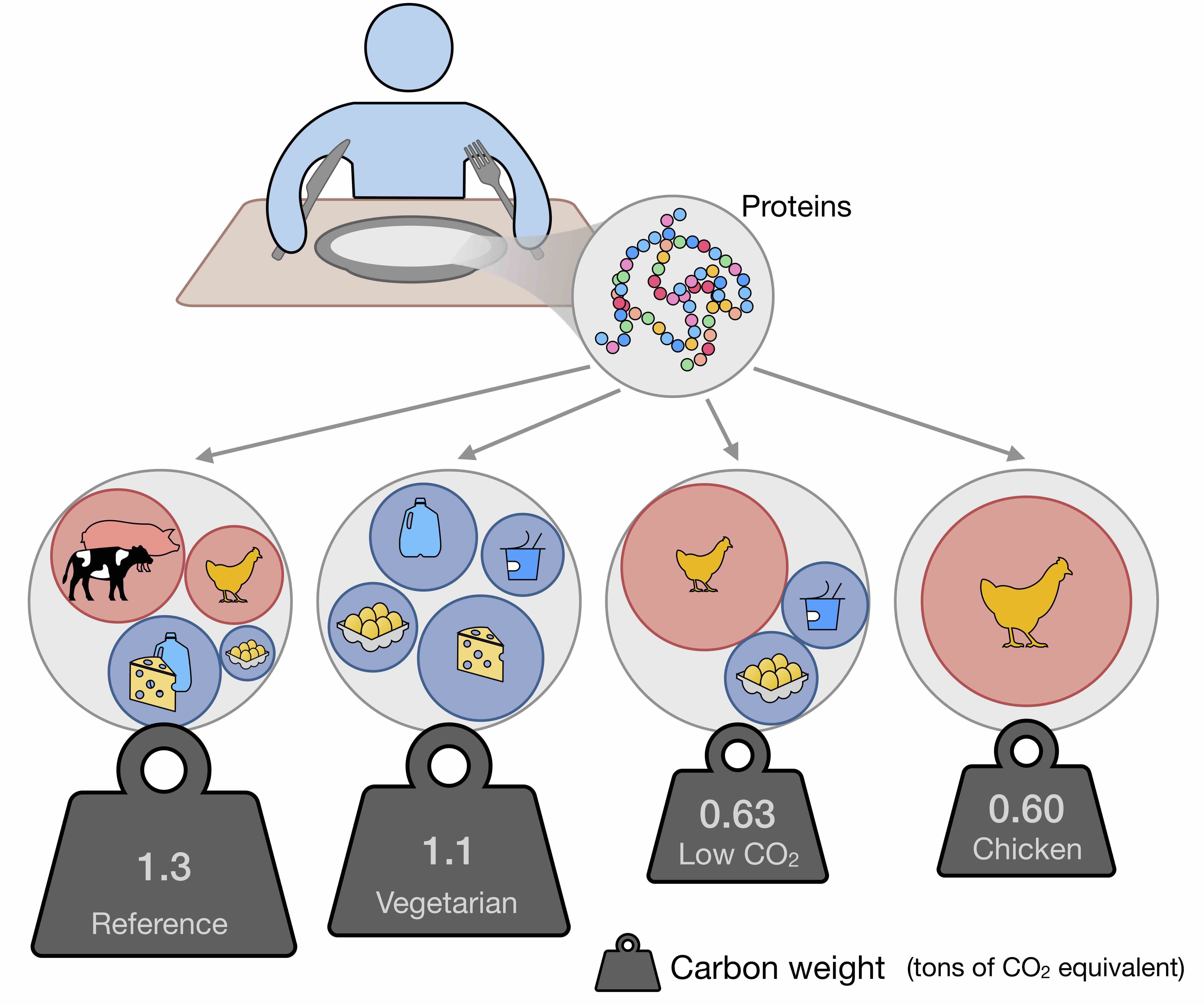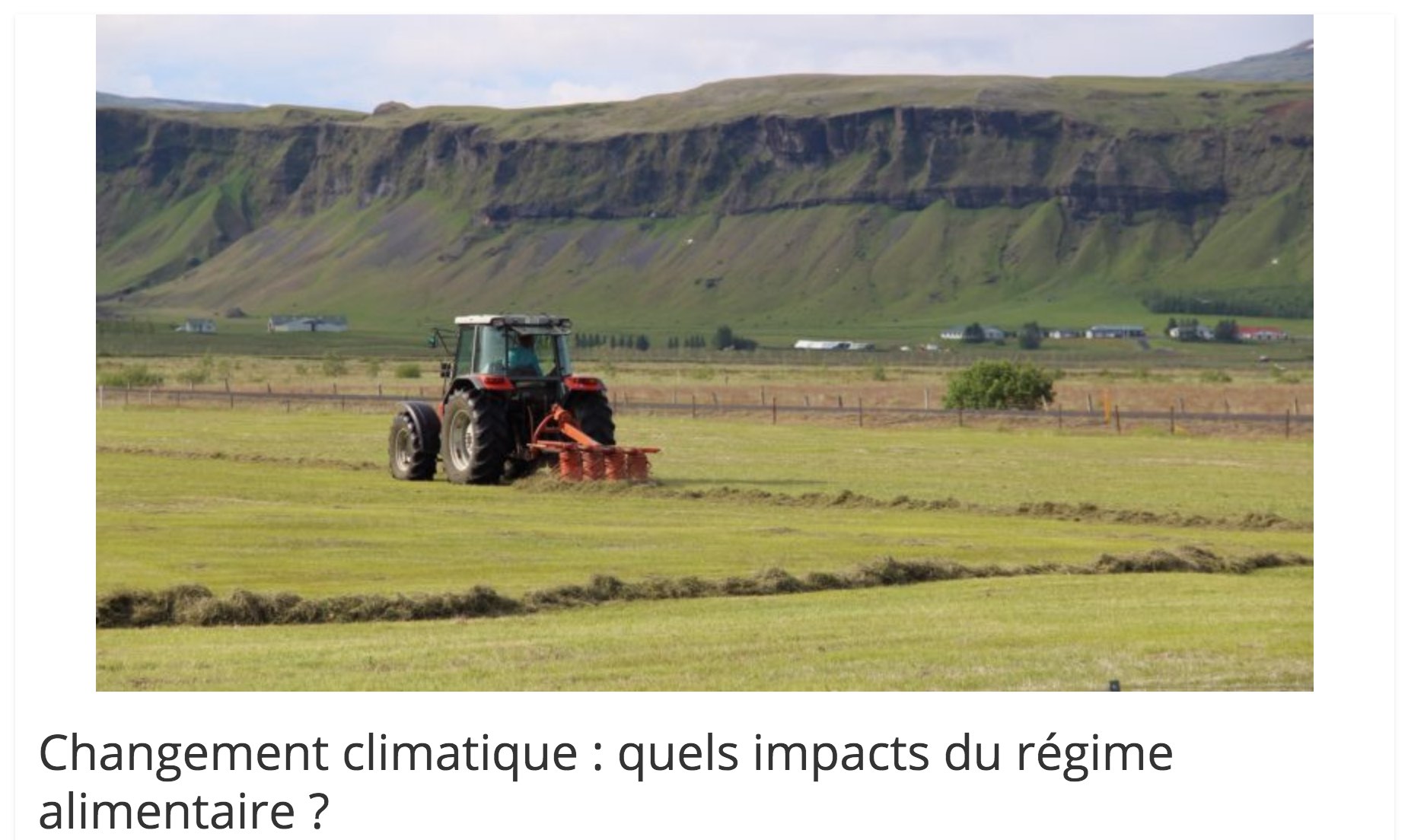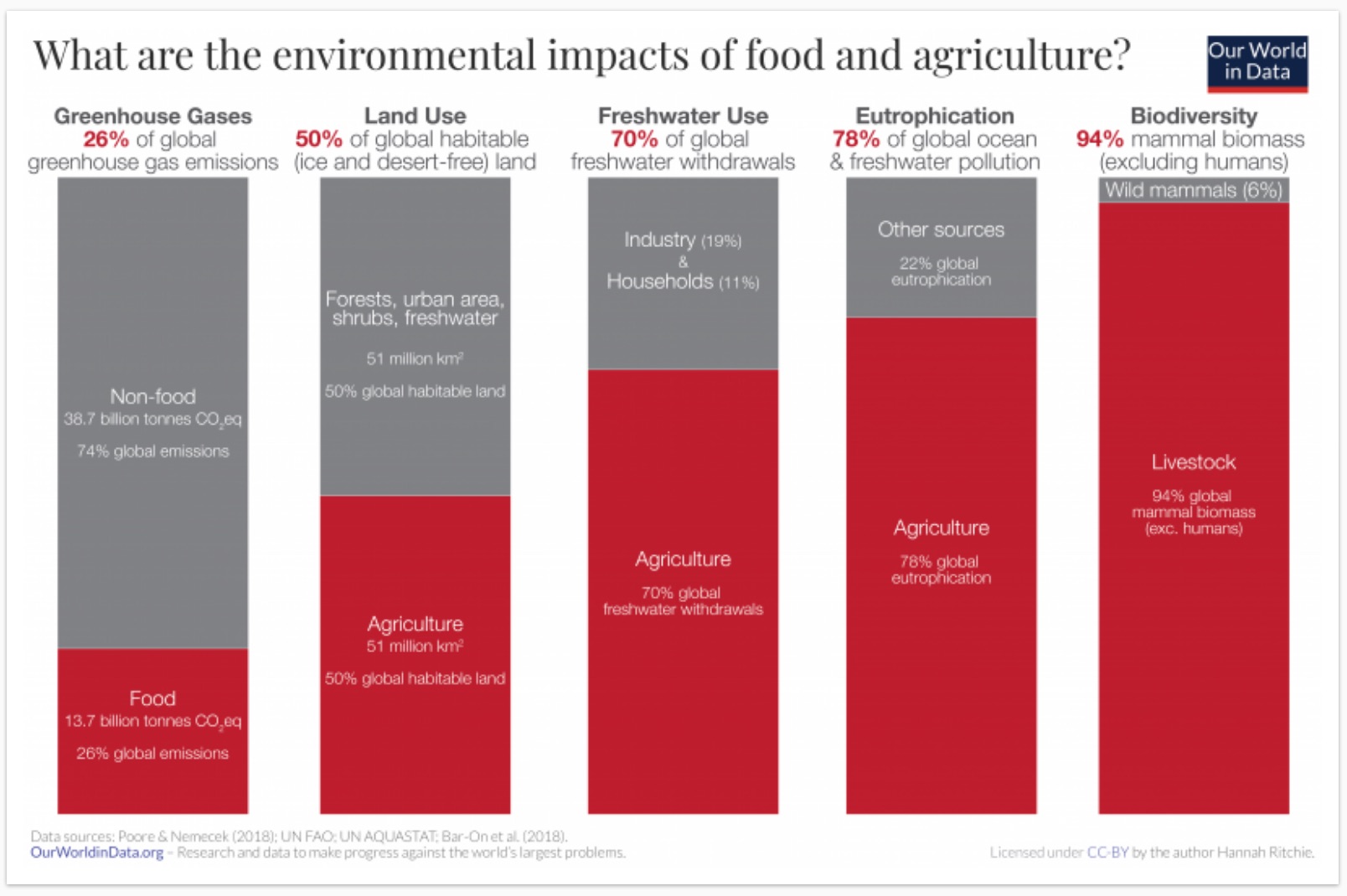Carbon impact of Meat and Dairy

We rely vitally on proteins, but protein-rich foods such as meat and dairy have a significant carbon footprint. To compare meat and dairy products, we investigate which ones are the most carbon intensive per gram of protein. If you rely on dairy only ("vegetarian" diet), is it better for the environment? Can you change the kinds of meat you eat, keep the total proteins, and yet decrease your carbon footprint? We even have an app below! The content below is based on our detailed peer-reviewed publication.
There is now a clear scientific consensus on anthropogenic climate change. It is due to the emissions of green house gases (GHG) from all human activities (industry, transportation, etc.). The most abundant GHG is carbon dioxide ( CO2). To quantify the impact of all GHGs, scientists convert them to equivalent CO2 emissions. Food production in the world is responsible for 26% of the worlds total emissions (13.7 billion tons CO2 equivalent). Livestock alone accounts for 14% of total emissions. This is mainly due to methane emissions of ruminants and land use change (for example soil contamination). According to the IPCC , global emissions have to decrease by 25% (respectively 45%) by 2030 to keep global warming under 2.0°C (respectively 1.5°C). These goals can only be reached through significant reduction of our food carbon footprint. Fortunately some foods have a much lower impact than others. Thus our food choices can largely influence our carbon footprint. But exactly which choices are smarter? This is what we explore, here with a focus on meat and dairy proteins.
Why do we eat meat and dairy? Not just because they offer delicious flavors but also because they contain vital proteins. We require at least 0.8g of protein per kg, that's about 50g if you weigh 60 kg (130 lbs, find out more on proteins). Other foods (such as legumes and fish) also contain proteins yet today they are not our major source of protein intake. Therefore we focus here on a variety of meats, on dairy such as milk, cheese, and yogurt and eggs. Not only do these products have different carbon footprints, but they also contain very different amounts of proteins: 100g of chicken contains about 20g of protein while 100g of milk (1/2 cup) contains only 3g. To compare these foods we are thus going to rely on their carbon footprint per protein content.
We carefully reviewed a number of peer-reviewed studies to derive this data (see the detailed article). This allows to establish a product ranking, which is summarized in the figure below. Beef, veal, lamb, cheese and milk come first, while chicken, duck and rabbit are on the lower end. In fact, ruminants (such as cows and muttons) emit large quantities of methane, a much more impactful GHG than CO2. This is one of the factors explaining why beef, veal, and lamb therefore score about 10 times higher than poultry. Milk, cheese, and yogurts, all score quite high for the same reason.
Based on this data, we can find the carbon footprint of meat and dairy in a typical western diet: the average European diet. It contains a mix of all of these products. The total carbon footprint of meat and dairy in this diet is 1.3 tons CO2 equivalent. Let’s explore alternative mixes and their carbon impact. Importantly, when trading a product for another, we keep the protein intake from meat and dairy constant.
Let's consider a (lacto-ovo-)vegetarian diet, replacing all meat by dairy and eggs. Obviously you would have to eat more dairy than usual to get the same amount of proteins. We find that this substitution lowers your carbon footprint only by a quarter. Note that this scenario has other nutritional consequences. For example iron is easily found in meat, yet not as much in dairy. This would call for including other sources of iron in the diet (such as beans, seeds, some vegetables or other fortified food).
Another diet option is to keep only the lowest carbon intensive products (here yogurt, eggs, chicken). In that case we find that the substitution cuts your carbon footprint by more than half!
The lowest carbon footprint one can achieve by keeping the total input of meat and dairy protein constant is by eating only chicken, rabbit and duck. This cuts the carbon footprint to a third of its initial value! Compared to the global objective (-45% by 2030) the low carbon products or chicken only diet would thus represent a substantial contribution (-5% reduction overall).
Fully replacing items in a diet can be quite daunting, yet starting by simple changes can make a difference. For example, if one trades 1 steak of beef for 1 steak of chicken each week, in a year a quarter ton of carbon emissions will be saved. This is already 20% of reduction in the carbon footprint in a european diet! You can check out more simple changes by playing with our app below.
To conclude, replacing ruminant products by chicken or other poultry/small animals is an option to reduce significantly one's carbon footprint. Replacing meat and dairy by other sources of proteins (legumes, specific seafood) is also an option to reduce carbon footprint. We will soon investigate those in more detail (please comment on Twitter if you are interested!).
and if you have more questions such as... what's best?
For ruminant meats (beef, lamb) and dairy transport represents a small part of the carbon footprint. The question has to be sorted on a case by case basis, and is greatly dependent on the production system -- for example lamb imported from an optimized lamb production system in New Zealand to the UK is generally less carbon intensive than lamb locally produced in the UK. However all other meat products and eggs have generally a lighter carbon footprint if produced locally.
The current data on organic versus non-organic production systems suggests that in general organic meat and dairy protein products lead to a higher carbon impact than non-organic, especially via land use change -- since organic breeding generally requires more land space. However, at this stage, there is large variability and more in-depth studies are required to assess the climate impact of organic versus non-organic meat and dairy farms.
Cow's milk appears to be generally less carbon intensive per g of protein than other milks such as goat, sheep and buffalo. This may be due to the fact that cow production systems being more common, they may be more optimized. Comparing milk from different species is only at its early stage, however, and is quite subtle because different milks have varied nutritional content beyond their protein content.
The protein content of cooked and aged cheese is generally higher (over 30g/100g of edible cheese) than fresh cheese (around 10g/100g). Yet, cooking and aging requires time and energy and therefore the carbon content of aged cheese is higher. However, cooking and aging also generate a number of byproducts (such as butter, cream, and whey) that "take their share" of the carbon footprint. Assembling data from many different cheese carbon footprint analysis, we observed no clear trend between carbon footprint per protein and protein content. This hints that effects compensate; the carbon impact per g of protein does not depend significantly on the cheese’s protein content.
